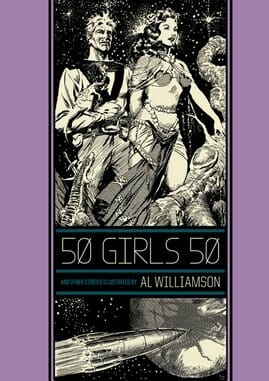
Writers: Al Feldstein, Others
Artists: Al Williamson, Frank Frazetta, Roy G. Krenkel, Others
Publisher: Fantagraphics
Release Date: April 6, 2013
Fantagraphics has been doing a loving job reprinting selections from EC’s historical vault of crime, horror, and sci-fi in its EC Library, with volumes devoted to the work of such pioneering authors as Wally Wood, Al Feldstein, and Harvey Kurtzman. This week brings collections from both Jack Davis (‘Taint the Meat…It’s the Humanity!) and Al Williamson, the latter of which reintroduces the youngest EC artist’s stories from Weird Science and Weird Fantasy, as well as a few crime and shock titles, in “50 Girls 50” and Other Stories (The EC Comics Library). The book’s introduction by Mark Schultz is full of useful tidbits, with some nuggets of information on each and every story. The format can become a little repetitive, but it’s good and necessary scholarship. Schultz’s essay is titled “Triumph of a Romanticist,” but it might as well be called “Triumph of a Delegator.” Williamson knew his strengths (character design, fine line work, innovative use of Zip-A-Tone and Craftint hatching board), but he also seems to have worked significantly slower than Davis, for one. Williamson relied heavily on his compatriots Roy Krenkel and Frank Frazetta for assistance (Krenkel had a particular gift for architectural renderings), with few works completed under Williamson’s sole signature. Schultz never minimizes that aspect of Williamson’s career, but he also puts it in perspective: Williamson was ambitious. When he had the time to do the work himself, as with his first EC story, “The Thing in the Glades,” the results are spectacular. Drawing on the work of illustrators J.C. Coll and Alex Raymond (Flash Gordon), Williamson crammed his panels with delicate lines, interesting shading, and expressive figures.
His characters are thoroughly physical beings, who squat and embrace, crouch and run; but there’s a definite romanticism to the way they’re heroicized. At first it seems as though a thematic vein of mild homoeroticism runs through the stories (all these well-built young men in very tight pants, hanging out together), but Williamson’s tales that feature women are explicitly heterosexually erotic. He seems, rather, to excel at depicting the joy of fitness and youth, being alive in a body that responds eagerly to your will. No doubt Frazetta’s influence can be seen in this aspect of his work, but Williamson’s humans (and aliens!) are more ethereal and, ultimately, classier than Frazetta’s. He also makes an interesting contrast to Davis, whose style is more distinctive and whose speed is apparent without diminishing the assurance of his composition. Williamson relied more on photo reference and experimented more with panel structure when he could, rendering some truly magical visual effects. This restlessness also means his work can be less even than Davis’, but when it works, it holds an eerie beauty, especially when realized over the course of his career.
GET PASTE RIGHT IN YOUR INBOX
The best music, movies, TV, books, comedy and more.